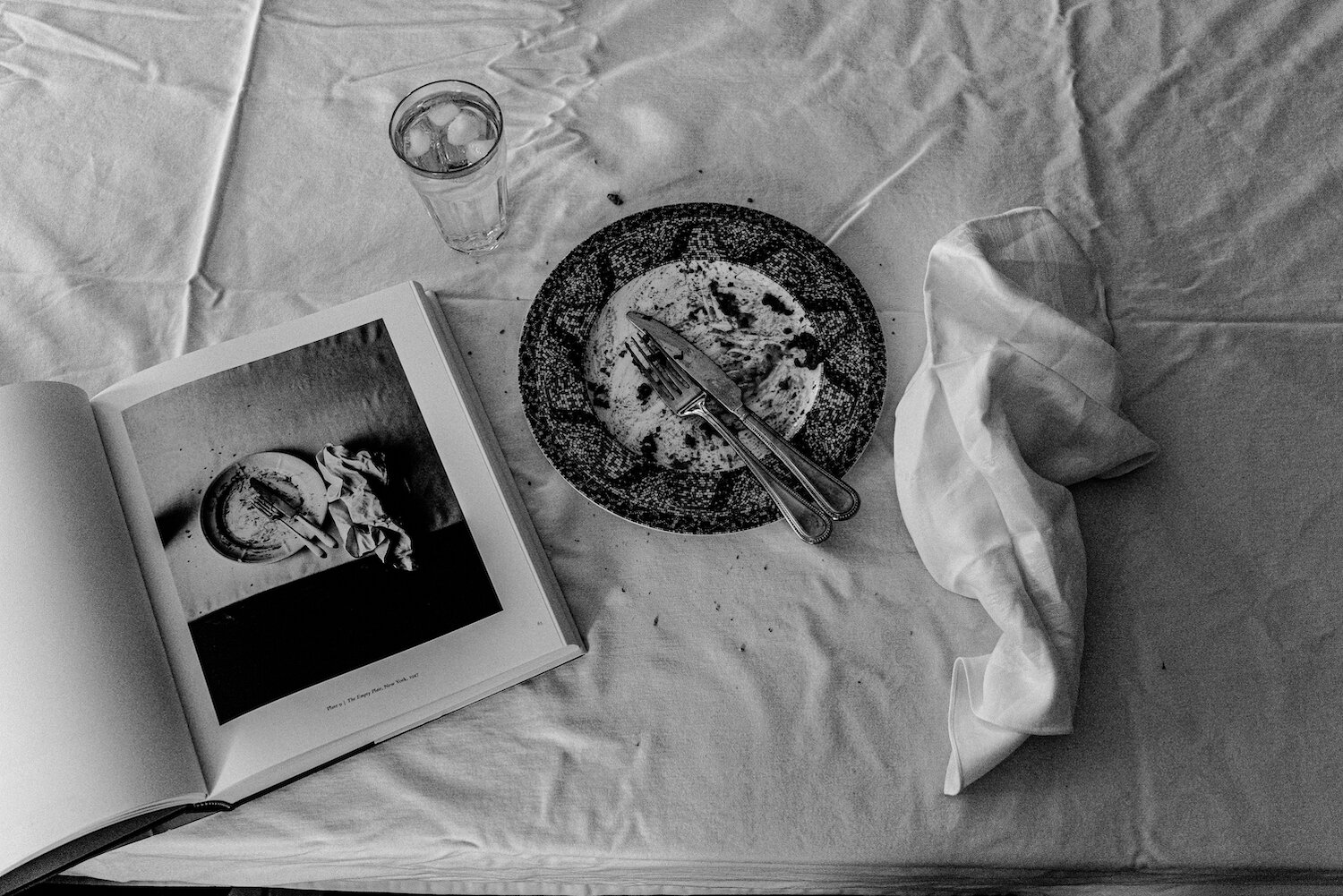The Empty Plate
In 1947, Irving Penn’s photo, The Empty Plate was published. As soon as I saw it I loved this photo. My heart went out to this photo. My heart was this photo.
I’ve tried to photograph my own version of it a few times. And I just gave it another try. As an exercise this is a great thing to do because you realize how nuanced the thing that you’re riffing on really is. The artfully crumpled napkin with all its planes and folds touches the plate but only in one spot. It reminds me of two lovers on a bed, tentatively touching each other after a fight. Are we okay? Can we embrace? Not yet. Not yet. It reminds me of an art history lesson on folded drapery on Greek and Roman sculpture. The food residue on the plate is an abstract painting. When I attempted the same set-up myself it took me a few tries before I was satisfied with the placement of the knife and fork. In the Penn photo, there is a shadow coming in from the left side. Is it the shadow of a glass of water? A coffee cup? I decided for my version to use a glass of water. However, the light in my photograph ends up being nothing like his. I go with what I have. There are crumbs on his tablecloth and rumples and some kind of bubbled areas. I had taken my tablecloth out of the linen closet and there are creases from where it was folded and quite a lot of rumples. I put some food on the plate and then I scraped it off and put it back in the fridge with the rest of the leftovers. I wasn’t hungry. It’s a lie, but it’s the truth, also.
The exercise isn’t to make an exact replica but to try to capture a feeling and to try to more deeply understand where the greatness of the original resides. A thousand little accidents and quite a bit of intention. Did he place each crumb around the plate or were they all just happy accidents? Was the plate smeared just so after an actual meal, or was it a combination of that and some manipulation? Did anyone eat what was on Penn’s plate? The answers to these questions don’t really matter. It’s good to ask them though.
The beauty of still life is that it might by its presence ask the question who was there before and who will be there after? Is this a restaurant? Who ate the meal? And who will clear the plate? But we might also wonder, is this an imaginary scene, a constructed one, or a natural one? Again, I don’t think the answers matter so much as the wondering. A still life is a site for wondering, imagining possibilities, for flights of fancy. How does ordinary life transpire, in what small gestures, and in what tiny spheres? What residue do we leave? What is it to be so done, so empty? If the plate is empty does this mean someone is sated? What kind of hunger was alleviated? How deep? Did the human leave content or with a heavy heart?
The thing that I’ve not mentioned and which is part of what draws me to the Penn photograph has nothing to do with the image. It’s a quotation from The Waves by Virginia Woolf. I’m not the only one who loves it; it’s widely quoted.
“How much better is silence; the coffee-cup, the table. How much better to sit by myself like the solitary sea-bird that opens its wings on the stake. Let me sit here for ever with bare things, this coffee-cup, this knife, this fork, things in themselves, myself being myself.”
When I’m looking at Penn’s photo, I’m feeling also Woolf’s words. I’m looking at the objects and thinking about silence, the solitary sitting, bare things. I am myself being myself.
That still life is about making connections both internally within the composition but also externally. There is a way that things rhyme and half-rhyme. A colour and shape together will echo another one though their meanings and connotations are quite different. An object will set off a memory, remind one of a scent, recall a dream, or a hint of a forgotten moment. A passage from a favourite book will sit down with you at the table.
Words and images will speak to each other through time. This doesn’t perhaps mean much other than that you were paying attention. You were feeling things. You were allowing sparks to fly. You were allowing the universe in.
I was going to write a post that more directly addresses the surreal world we’re currently living in. And I’m sure I’ll be doing more of that, though others are doing a good job of digging into the nuances of it and how this is affecting some of us differently than others, and what that’s going to look like afterwards. Whatever we write now, is going to say something about the time. I was thinking about why I was drawn to this particular image right now. And maybe it is just that I’ve been mulling over the before and afters of where we are right now. The unknowns. Which is the same with the Irving Penn photograph. It says so much, and leaves us not knowing anything for certain.
Someone walks into a room, dines, wipes their mouth, leaves.
There’s a whole life around that moment, an entire long story. A mystery.








